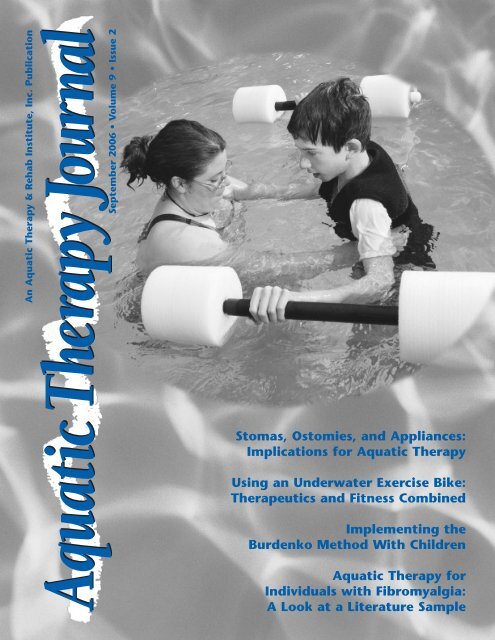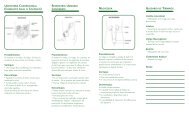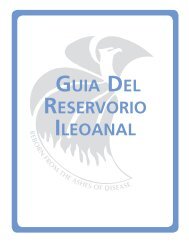Swimming and Aquatic Therapy for Ostomates - United Ostomy ...
Swimming and Aquatic Therapy for Ostomates - United Ostomy ...
Swimming and Aquatic Therapy for Ostomates - United Ostomy ...
Create successful ePaper yourself
Turn your PDF publications into a flip-book with our unique Google optimized e-Paper software.
An <strong>Aquatic</strong> <strong>Therapy</strong> & Rehab Institute, Inc. Publication<br />
September 2006 • Volume 9 • Issue 2<br />
Stomas, Ostomies, <strong>and</strong> Appliances:<br />
Implications <strong>for</strong> <strong>Aquatic</strong> <strong>Therapy</strong><br />
Using an Underwater Exercise Bike:<br />
Therapeutics <strong>and</strong> Fitness Combined<br />
Implementing the<br />
Burdenko Method With Children<br />
<strong>Aquatic</strong> <strong>Therapy</strong> <strong>for</strong><br />
Individuals with Fibromyalgia:<br />
A Look at a Literature Sample
The <strong>Aquatic</strong> <strong>Therapy</strong> Journal is<br />
published biannually by the<br />
<strong>Aquatic</strong> <strong>Therapy</strong> & Rehab<br />
Institute, Inc. <strong>and</strong> the <strong>Aquatic</strong><br />
Exercise Association. The <strong>Aquatic</strong><br />
<strong>Therapy</strong> Journal articles are peer<br />
reviewed to insure the highest<br />
quality in<strong>for</strong>mation.<br />
ATRI prohibits discrimination on<br />
the basis of race, color, religion,<br />
creed, sex, age, marital status,<br />
sexual orientation, national origin,<br />
disability, or veteran status in the<br />
treatment of participants in,<br />
access to, or content of its programs<br />
<strong>and</strong> activities.<br />
Articles may be submitted as a<br />
contribution to the profession;<br />
no remuneration can be made.<br />
Submissions should be directed to<br />
Managing Editor Susan J. Grosse,<br />
sjgrosse@execpc.com.<br />
For permission to reprint <strong>for</strong><br />
academic course packets, please<br />
send a written request to<br />
info@aeawave.com.<br />
For Subscription <strong>and</strong> Membership<br />
in<strong>for</strong>mation, please contact<br />
AEA, info@aeawave.com,<br />
phone: 941.486.8600<br />
Opinions of contributing authors<br />
do not necessarily reflect the<br />
opinions of AEA <strong>and</strong> ATRI.<br />
©2006 AEA/ATRI-Nokomis, Florida<br />
Volume 9, Issue 2<br />
Managing Editors: Sue Grosse<br />
Ruth Sova<br />
Graphic Design: Carolyn Mac Millan<br />
Printing: Target Graphics<br />
US $17.00<br />
1 <strong>Aquatic</strong> <strong>Therapy</strong> Journal • September 2006 • Volume 9 • Issue 2<br />
Table of Contents<br />
Feature Articles<br />
Stomas, Ostomies, <strong>and</strong> Appliances: Implications <strong>for</strong> <strong>Aquatic</strong> <strong>Therapy</strong> . . . . . . . 3<br />
Sue Skaros, BA, BS, PA-C; Sarah Lundeen, MSN, NP<br />
Charles Mathison, BSN, CWOCN <strong>and</strong> Mary Otterson, MD, MS<br />
Using an Underwater Exercise Bike: Therapeutics <strong>and</strong> Fitness Combined . . . 11<br />
Carrie Paterson, BS, F.J. Gaenslen School, Milwaukee, WI<br />
Implementing the Burdenko Method With Children . . . . . . . . . . . . . . . . . . . 16<br />
Paula Ray, OTR & Tera Galloway, CPT<br />
<strong>Aquatic</strong> <strong>Therapy</strong> <strong>for</strong> Individuals with Fibromyalgia: . . . . . . . . . . . . . . . . . . . 21<br />
A Look at a Literature Sample<br />
Janet MK Gangaway, DPT, OCS, ATC, ATRIC<br />
Assistant Professor of Physical <strong>Therapy</strong>, University of Hart<strong>for</strong>d, CT<br />
Feature Columns<br />
Pool Problems: Chlorine Smell . . . . . . . . . . . . . . . . . . . . . . . . . . . . . . . . . . . . 7<br />
Alison Osinski, Ph.D., <strong>Aquatic</strong> Consulting Services, San Diego, CA<br />
Interface: <strong>Aquatic</strong> <strong>Therapy</strong> Professionals Interact with…Educators . . . . . . . . . 9<br />
Carrie Paterson, BS, Physical Education Specialist,<br />
F.J. Gaenslen School, Milwaukee, WI<br />
Research Review . . . . . . . . . . . . . . . . . . . . . . . . . . . . . . . . . . . . . . . . . . . . . . 15<br />
New <strong>for</strong> Your Library . . . . . . . . . . . . . . . . . . . . . . . . . . . . . . . . . . . . . . . . . .15<br />
Around <strong>and</strong> About the Industry . . . . . . . . . . . . . . . . . . . . . . . . . . . . . . . . . . 23<br />
Web Waves . . . . . . . . . . . . . . . . . . . . . . . . . . . . . . . . . . . . . . . . . . . . . . . . . . 25<br />
Others<br />
From the Editors . . . . . . . . . . . . . . . . . . . . . . . . . . . . . . . . . . . . . . . . . . . . . . . 2<br />
Jalkanen Foundation <strong>and</strong> ATRI Award Scholarships . . . . . . . . . . . . . . . . . . . . 10<br />
<strong>for</strong> <strong>Aquatic</strong> <strong>Therapy</strong> Studies<br />
ICATRIC Updates . . . . . . . . . . . . . . . . . . . . . . . . . . . . . . . . . . . . . . . . . . . . . 25<br />
ATRI Mission Statement<br />
The <strong>Aquatic</strong> <strong>Therapy</strong> & Rehab Institute, Inc. (ATRI) is a non-profit, educational corporation<br />
dedicated to the professional development of health care providers in the area of<br />
aquatic therapy. Offering educational courses, ATRI provides opportunities to advance<br />
the competencies, knowledge <strong>and</strong> skills of the aquatic therapist.<br />
AEA Mission Statement<br />
The <strong>Aquatic</strong> Exercise Association is a not-<strong>for</strong>-profit educational organization dedicated to<br />
the growth <strong>and</strong> development of the aquatic fitness industry <strong>and</strong> the public served.<br />
On the Cover:<br />
Learn more about utilizing the Burdenko Method with children in the article by<br />
Paula Ray <strong>and</strong> Terra Galloway, found on page 17.
In the exam room was a middle-aged<br />
woman returning to our clinic after<br />
having part of her bowel removed. She<br />
was adapting well to having a stoma,<br />
<strong>and</strong> felt “fine”, but still seemed a bit<br />
“down-in-the-dumps”. When asked<br />
what her biggest concern was about<br />
having a stoma, she replied, “I can’t go<br />
swimming anymore, <strong>and</strong> I really miss<br />
it!” Staff tried to reassure her she certainly<br />
could go swimming, but she continued<br />
to be skeptical. She was afraid<br />
her appliance (bag) might fall off, or<br />
she might leak material into the water.<br />
She said she would be “absolutely mortified”<br />
if this happened <strong>and</strong> was afraid<br />
to even try.<br />
Her concerns are very real concerns.<br />
However, are they realistic? Can<br />
people with stomas engage in aquatic<br />
activities? What about clients with<br />
indwelling catheters or tubes? What are<br />
the risks? What if an appliance leaks?<br />
Worse yet, what if it falls off or comes<br />
out? Is it better to just avoid problems<br />
<strong>and</strong> have these individuals stay out of<br />
pool water? Or, is the fear greater<br />
than reality?<br />
Stomas<br />
Stomas, Ostomies, <strong>and</strong> Appliances:<br />
Implications <strong>for</strong> <strong>Aquatic</strong> <strong>Therapy</strong><br />
A stoma is a surgically created opening<br />
in the skin to allow drainage of urine<br />
or fecal material. (See Figure 1*) It<br />
results from surgery to remove the urinary<br />
bladder, or part of the bowel<br />
because of disease or injury. The type<br />
of surgery an individual undergoes<br />
determines the appliance system which<br />
must be used in place of natural<br />
human anatomy. Once an appliance is<br />
functional, <strong>and</strong> all surgical sites are<br />
healed, an individual is expected to<br />
resume regular activities. While excretion<br />
of waste is no longer controlled<br />
by the individual, presence of an appliance<br />
which catches this waste allows<br />
them to be considered continent.<br />
3 <strong>Aquatic</strong> <strong>Therapy</strong> Journal • September 2006 • Volume 9 • Issue 2<br />
With a urostomy, urine no longer empties<br />
from the bladder. Instead, a section<br />
of small bowel is separated out to create<br />
a new bladder, <strong>and</strong> urine drains out of<br />
the stoma into a disposable appliance or<br />
collection bag. Some urostomies are<br />
continent, meaning they do not drain<br />
into a bag. Instead, they require periodic<br />
catheter insertion to empty the neobladder.<br />
Initially, there are bacteria in<br />
the urine from normal bowel flora, but<br />
within a very short time, unless there is<br />
an infection, urine in this bowel segment<br />
becomes sterile. Stool no longer<br />
enters this part of the bowel (Hollister,<br />
2003). However, urine in the collection<br />
bag is considered contaminated.<br />
With an ileostomy or colostomy stool<br />
is no longer evacuated through the rectum<br />
<strong>and</strong> anus. Instead, it is collected in<br />
a disposable appliance that must be<br />
periodically emptied. People with<br />
ileostomies <strong>and</strong> colostomies are unable<br />
to control the elimination process. They<br />
are, however, able to prevent spillage<br />
<strong>and</strong> leakage of fecal contents by using<br />
an appliance, thus having their elimination<br />
under control.<br />
*Figure 1— Ileostomy Anatomy supplied courtesy<br />
of Hollister Incorporated, 2000 Hollister Drive,<br />
Libertyville, IL 60048-3781<br />
Sue Skaros, BA, BS, PA-C<br />
Sarah Lundeen, MSN, NP<br />
Charles Mathison, BSN, CWOCN<br />
Mary Otterson, MD, MS<br />
An ileostomy involves fecal drainage<br />
from the last part of the small intestine.<br />
Evacuated material will be quite liquid.<br />
A colostomy drains fecal contents from<br />
the large bowel or colon. Because this<br />
is the part of the bowel where water is<br />
reabsorbed, evacuated matter will be<br />
less liquid, <strong>and</strong> thicker than that from<br />
the small intestine (Hollister 2003).<br />
Every stoma is just a little bit different.<br />
Some protrude, others don’t. They<br />
should never be painful, but they<br />
should be bright pink <strong>and</strong> moist.<br />
Because of the significant blood supply<br />
to the bowel, they may bleed easily if<br />
bumped or rubbed. This is not abnormal,<br />
usually occurs in small amounts,<br />
<strong>and</strong> stops within a very short time. Of<br />
course, persistent or vigorous bleeding<br />
would necessitate a phone call to<br />
the client’s Wound, <strong>Ostomy</strong> <strong>and</strong><br />
Continence Nurse (WOCN) or physician<br />
(Hollister, 2004).<br />
Stomas are usually ready <strong>for</strong> immersion<br />
in water, whether bath or swimming, by<br />
the time the surgical wound has completely<br />
healed. However, a stoma<br />
should not be immersed without first<br />
obtaining clearance from the surgeon.<br />
All clients with fresh (less than two<br />
months old) stomas should obtain a<br />
release from their surgeon be<strong>for</strong>e engaging<br />
in aquatic activities. Open water<br />
activities (as opposed to pool-centered<br />
ones) should be undertaken with caution.<br />
The higher load of bacteria <strong>and</strong><br />
parasites found in open water may preclude<br />
those individuals who are<br />
immunosuppressed or who have medical<br />
conditions, such as kidney failure<br />
which can predispose them to infection.<br />
Appliances <strong>and</strong><br />
<strong>Aquatic</strong> Participation<br />
Appliances are devices used when normal<br />
anatomy is no longer able to per<strong>for</strong>m<br />
its usual function. Prosthesis is<br />
➤
the term used when a device is used to<br />
replace a missing part of the anatomy.<br />
For the purpose of this article, the<br />
term “appliance” will be used <strong>for</strong> both<br />
conditions.<br />
There are two main types of pouching<br />
systems used with stomas—One-piece<br />
system <strong>and</strong> Two-piece system. The onepiece<br />
system has the tape, skin, barrier,<br />
<strong>and</strong> pouch in layers <strong>and</strong> adheres directly<br />
to the skin. This system requires<br />
complete removal whenever the pouch<br />
needs to be changed. However, it can be<br />
emptied without removing the device.<br />
The two-piece system has a separate<br />
adherent skin barrier with a plastic<br />
flange on it. The pouch has a reciprocal<br />
flange, which allows it to be attached to<br />
the skin barrier, <strong>and</strong> it can be removed<br />
<strong>for</strong> changing without disrupting the<br />
skin barrier. This device can also be<br />
emptied without removing the pouch<br />
(Hollister, 2003).<br />
In addition, there are disposable, temporary<br />
bags that can be used by clients<br />
who have continent stomas or drainage<br />
catheters, <strong>and</strong> choose not to, or cannot<br />
cover them with an occlusive dressing.<br />
Mini-bags <strong>and</strong> non-drainable low profile<br />
bags are also available, <strong>and</strong> might be<br />
preferable <strong>for</strong> aquatic activities.<br />
Pouches with built in filters <strong>for</strong> releasing<br />
gas need to be avoided <strong>for</strong> use during<br />
aquatic activities because they allow<br />
the drainage bag to fill with water, <strong>and</strong><br />
cause effluent to leak back out through<br />
the filter. (<strong>Ostomy</strong> Association of<br />
Southwestern Indiana, 2006). People<br />
with ostomies, or their caregivers, are<br />
taught how to care <strong>for</strong>, empty, clean,<br />
<strong>and</strong> change their appliances be<strong>for</strong>e <strong>and</strong><br />
after their surgical procedures<br />
(CaregiverPA, 2006).<br />
Pouches may be closed <strong>and</strong> require<br />
removal <strong>and</strong> disposal, or drainable<br />
which can be emptied repeatedly.<br />
Drainable devices are designed <strong>for</strong> fecal<br />
systems using either a clamp or plastic<br />
fasteners <strong>and</strong> <strong>for</strong> urinary systems using<br />
a drain valve with or without an extension<br />
(Hollister, 2003). Draining these<br />
pouches immediately be<strong>for</strong>e entering<br />
the pool minimizes possibility of leakage.<br />
Depending upon how quickly the<br />
appliance fills, the client may need to<br />
leave the pool periodically to empty the<br />
bag. Usually, this would only be the<br />
case <strong>for</strong> individuals with urostomies, as<br />
it is a known physiologic response that<br />
urine output is increased when people<br />
are immersed in water which is cooler<br />
than normal body temperature.<br />
Catheters are another type of drainage<br />
system. Some clients may have a tube<br />
protruding from the stoma, such as a<br />
supra-pubic tube <strong>for</strong> draining the bladder,<br />
a gastrostomy tube into the stomach,<br />
or a jejunostomy tube into the<br />
small bowel. The last two of these are<br />
<strong>for</strong> nutrition purposes. These catheters<br />
may be capped when not in use. In<br />
addition, if these devices are very pliable,<br />
they can be covered with an occlusive<br />
dressing to keep them away from<br />
water exposure.<br />
Indwelling catheters are considered to<br />
be contaminated. Bacteria most often<br />
associated with this contamination are<br />
usually opportunistic skin flora which,<br />
more often than not, pose more of a<br />
threat to the client than to others.<br />
However, individuals who have associated<br />
illnesses such as diabetes, kidney<br />
failure, or cancer, or are immunosuppressed<br />
may also have contamination<br />
with Methicillin Resistant Staphylococcus<br />
aureus (MRSA) <strong>and</strong> Pseudomonas<br />
species, which may cause problems to<br />
others in aquatic settings (Maki, 2001).<br />
For additional in<strong>for</strong>mation on working<br />
with individuals with MRSA, please<br />
refer to Skaros, S. (2006). MRSA –<br />
Shark or Guppy? <strong>Aquatic</strong> <strong>Therapy</strong><br />
Journal. 8(1), pp 11-15, February.<br />
Ideally, rigid or non-pliable tubes<br />
should be removed, with the approval<br />
of the client’s physician, <strong>and</strong> the stoma<br />
covered with an occlusive dressing<br />
(Op-Site or Tegaderm) be<strong>for</strong>e<br />
engaging in any aquatic activities.<br />
Another option is to have the client<br />
place the tube inside of an attached<br />
temporary ostomy appliance, creating<br />
a closed system while they engage in<br />
aquatic activities. If they cannot be<br />
covered or enclosed, clients should not<br />
engage in aquatic activities, including<br />
aquatic therapy.<br />
of infected matter around the catheter<br />
into the water, as well as erosion of<br />
catheter tip <strong>and</strong> balloon into the wall,<br />
with subsequent bleeding. In addition,<br />
every time the drainage system is opened<br />
to disconnect the catheter from a<br />
drainage bag, bacteria are reintroduced<br />
into the system causing more contamination<br />
(WOCN, n.d.). Simply wrapping<br />
an occlusive dressing around the<br />
catheter where it enters through the skin<br />
is insufficient to reduce spread of potentially<br />
infectious material into the water.<br />
There<strong>for</strong>e, clients who cannot remove<br />
these catheters or place them inside of<br />
an ostomy appliance adhering directly to<br />
the skin, should not participate in aquatic<br />
activities.<br />
<strong>Aquatic</strong> Pre-participation<br />
Precautions<br />
Clients with stomas can take precautions<br />
to minimize likelihood of having a<br />
leak. After changing the flange, at least<br />
several hours, preferably overnight,<br />
should lapse be<strong>for</strong>e engaging in aquatic<br />
activities. This allows adequate adherence<br />
of the adhesive substance to the<br />
skin. The flange can be rein<strong>for</strong>ced with<br />
waterproof tape if the client is still concerned<br />
about leakage. An optional belt<br />
may be added to many appliances<br />
which will keep the appliance close to<br />
the body. Rubber belts are preferable to<br />
cloth ones as cloth belts have a tendency<br />
to stretch when wet (<strong>Ostomy</strong><br />
Association of Southwestern Indiana,<br />
2006). A pouch cover can be worn to<br />
help disguise the pouch, in addition to<br />
keeping it close to the body (Hollister,<br />
2003). Wearing a second swim suit or<br />
a tighter undergarment, such as biking<br />
shorts or a stretch panty girdle, under a<br />
swim suit can help hold the appliance<br />
in place, <strong>and</strong> reduce chance of it falling<br />
off. However, undergarments should<br />
not be tight enough to restrict flow<br />
of effluent into the bag (Ostomoy<br />
Association of Southwestern Indiana,<br />
2006).<br />
Male clients might consider wearing a<br />
boxer-style suit with an added appliance<br />
pouch on the inside. Females<br />
Attempts to place non-pliable devices should choose suits made of “busy”<br />
under an occlusive dressing may involve patterned fabric with ruffles, sashes, or<br />
folding the catheter, causing pressure on bows to help camouflage the presence<br />
the bladder, stomach, or bowel wall. of an appliance (<strong>Ostomy</strong> Association of<br />
This can cause spasming <strong>and</strong> extrusion Southwestern Indiana, 2006).<br />
➤<br />
September 2006 • Volume 9 • Issue 2 • <strong>Aquatic</strong> <strong>Therapy</strong> Journal 4
Other tips include—<br />
• Clients should not eat or drink <strong>for</strong><br />
several hours be<strong>for</strong>e engaging in<br />
aquatic activities as this will increase<br />
fecal output. At the least, they should<br />
refrain from chewing gum, drinking<br />
carbonated beverages <strong>and</strong> beer, or<br />
drinking through a straw within two<br />
hours of going in the water because<br />
this will increase gas output, <strong>and</strong><br />
cause the bag to fill more quickly.<br />
• Clients who have concerns about<br />
odor from their bags can consider<br />
using some mint mouthwash (not red<br />
as this can look like blood) or Certs<br />
in the pouch (<strong>Ostomy</strong> Association of<br />
Southwestern Indiana, 2006).<br />
• Clients should empty their pouch<br />
when it is 1/3 to 1/2 full, making sure<br />
to clean off the outside of drainage<br />
tabs be<strong>for</strong>e resealing (Hollister,<br />
2003). This should be done even if it<br />
means briefly leaving the pool during<br />
aquatic activity.<br />
• Female clients should consider wearing<br />
a “tankini” or two-piece type of<br />
suit to allow <strong>for</strong> ease of “burping” the<br />
collection bag if it fills with gas.<br />
• Clients with colostomies should, if<br />
possible, irrigate their ostomies in<br />
order to remove accumulated fecal<br />
matter prior to entering the water.<br />
• Remember, heat <strong>and</strong> exposure to<br />
water will shorten life of the skin barrier,<br />
requiring more frequent changing<br />
(<strong>Ostomy</strong> Association of Southwestern<br />
Indian, 2006).<br />
• Skin barriers require changing at least<br />
every seven days—more often if there<br />
are skin problems, liquid effluent, or<br />
in warm, humid environments.<br />
• Soaps which may interfere with the<br />
adhesives should be avoided. The<br />
client’s WOCN is a good resource<br />
regarding this concern.<br />
• Clients should keep a spare appliance<br />
with them in case of problems.<br />
• If the skin appears red, becomes<br />
painful, or the appliance is not staying<br />
attached, the WOCN or physician<br />
should be contacted <strong>for</strong> advice <strong>and</strong><br />
care (Hollister, 2003).<br />
Following these few hints will help the<br />
client feel more secure <strong>and</strong> com<strong>for</strong>table<br />
with their aquatic experience, <strong>and</strong> minimize<br />
risk of an adverse event.<br />
Contraindications to<br />
<strong>Aquatic</strong> Activity<br />
5 <strong>Aquatic</strong> <strong>Therapy</strong> Journal • September 2006 • Volume 9 • Issue 2<br />
When is aquatic activity, including<br />
aquatic therapy, contraindicated <strong>for</strong><br />
clients with stomas or tubes? Even<br />
though chlorine, ozone, <strong>and</strong> bromine<br />
are effective disinfectants, not all potential<br />
pool contaminating organisms are<br />
able to be destroyed in a timely manner<br />
(MMWR, May 25, 2001). There<strong>for</strong>e,<br />
be<strong>for</strong>e answering this question, several<br />
factors need to be considered—<br />
• What kind of facility is involved?<br />
Large, small, indoor, outdoor, open<br />
water, or pool? There is far less risk<br />
of infection in a large community size<br />
swimming pool than in a small therapy<br />
pool, as the larger quantity of water<br />
dilutes contaminants. Open water<br />
facilities are more likely to have larger<br />
quantities of bacteria <strong>and</strong> parasites<br />
than are pool facilities, thus posing a<br />
risk of infection <strong>for</strong> individuals with<br />
appliances.<br />
• What is the temperature of the water?<br />
There is far less risk of infection with<br />
minimal exposures in regular use<br />
pools with cooler water temperatures<br />
than in therapy pools with warm<br />
water temperatures.<br />
• Is the client continent? If not, can<br />
their incontinence be confined <strong>and</strong><br />
controlled by an appliance?<br />
• Can the client, or their caregiver, be<br />
compliant with good stoma hygiene<br />
<strong>and</strong> care?<br />
• Are clients with stomas or catheters<br />
being held to the same hygiene st<strong>and</strong>ards<br />
as anatomically intact clients?<br />
“Normal” clients can experience<br />
episodes of fecal incontinence when<br />
passing flatus (gas). Individuals may<br />
pass small amounts of urine either in<br />
or out of the water. Babies, prior to<br />
being toilet-trained, are participating<br />
in infant swim programs even though<br />
they have no control over their bowel<br />
or bladder functions. So, if no ef<strong>for</strong>t<br />
is being made to check <strong>for</strong> “skid<br />
marks” <strong>and</strong> yellow stains on the<br />
underwear of anatomically intact<br />
individuals, the same st<strong>and</strong>ard of<br />
continence must apply to those with<br />
stomas <strong>and</strong> catheters.<br />
Taking the above questions into consideration,<br />
when are aquatic activities, including<br />
aquatic therapy, contraindicated?<br />
These criteria apply to all individuals,<br />
not just those with stomas or catheters.<br />
<strong>Aquatic</strong>s is contraindicated <strong>for</strong> anyone—<br />
• who has had recent open surgery<br />
(having an incision <strong>and</strong> open<br />
wound), <strong>and</strong> has not been released by<br />
his or her surgeon.<br />
• with open sores, open wounds, or<br />
active skin infections.<br />
• with skin breakdown—areas where<br />
the skin is red, raw, <strong>and</strong> painful.<br />
• with active infection <strong>and</strong>/or fever<br />
involving any body system.<br />
• with diarrhea, defined as other than<br />
normal, healthy fecal output of an<br />
individual with a small bowel stoma<br />
<strong>and</strong> appliance, whether or not it may<br />
be infectious (Healthy <strong>Swimming</strong>,<br />
2006).<br />
• who is incontinent of either feces or<br />
urine—even if they wear diapers.<br />
Individuals with properly functioning<br />
appliances are considered to have<br />
continence under control. Diapers are<br />
not designed <strong>for</strong> exposure to large<br />
amounts of water that aquatics participation<br />
provides. They are inadequate<br />
<strong>for</strong> preventing spills <strong>and</strong> leaking<br />
when soaking wet, even with a rubberized<br />
outer pant (CDC, 2002).<br />
• who require an indwelling catheter<br />
which cannot be covered by an occlusive<br />
dressing or temporary appliance,<br />
<strong>and</strong>/or in whom covering results in<br />
possible injury to the client.<br />
Putting It All Into<br />
Perspective<br />
The biggest problem an individual with<br />
a stoma or catheter faces is their own<br />
self-esteem. Initially, they live in constant<br />
fear of “being different” <strong>and</strong>/or<br />
having the appliance fall off or leak. In<br />
reality, a well-fitted appliance is very<br />
secure. If clients are reluctant to participate<br />
in aquatic activities, they might be<br />
encouraged to observe pool activity<br />
while dressed in their pool attire.<br />
Advising them to spend a little extra<br />
time shopping <strong>for</strong> clothing which will be<br />
“just right” can go a long way in helping<br />
them to adjust to engaging in aquatic<br />
activities. There are many resources<br />
available on the internet, as well as<br />
through their WOCNs, which can be of<br />
great help in addressing their concerns.<br />
While changes in weight, certain soaps<br />
<strong>and</strong> lotions, <strong>and</strong> improper application<br />
➤
of the skin barrier can predispose<br />
clients to have accidents, once they<br />
become used to the device, there are<br />
few problems. Experts at ConvaTec<br />
(Bristol-Meyers, Squibb, 2005) even<br />
note risk of having an appliance fall off<br />
in water is extremely small. Most adhesives<br />
have been designed to not only be<br />
secure in water, but also bond more<br />
tightly when exposed to water.<br />
Additionally, they state, “You could dive<br />
in the water off the highest diving<br />
board <strong>and</strong> your bag will stay in place—<br />
your shorts may come down, but the<br />
bag won’t!” (ConvaTec, 2005, Chapter<br />
12). However, the authors advise<br />
against trying this.<br />
With today’s adhesives <strong>and</strong> appliances,<br />
risk of leakage is even less likely.<br />
Making sure the appliance fits well <strong>and</strong><br />
is properly applied is a major step in<br />
preventing leakage. Rein<strong>for</strong>cing the skin<br />
barrier with water proof tape, wearing a<br />
belt, pouch cover, <strong>and</strong> close fitting garments,<br />
frequent emptying of the bag,<br />
<strong>and</strong> immaculate skin care are key to<br />
maintaining a continent appliance. The<br />
more experience <strong>and</strong> positive results<br />
stoma <strong>and</strong> catheter users have, the<br />
more their self-esteem will grow <strong>and</strong><br />
their fears lessen.<br />
Should the worst possibility, a large leak<br />
or an appliance falling off with fecal<br />
exposure, occur, decontamination of<br />
the facility should be undertaken following<br />
Centers <strong>for</strong> Disease Control <strong>and</strong><br />
Prevention (CDC) guidelines, under<br />
supervision of the facility’s certified<br />
pool operator (MMWR, 2001).<br />
Anatomically intact participants who<br />
fail to take a naked, hot, soapy shower<br />
be<strong>for</strong>e entering the water are constantly<br />
depositing, into the water as they swim,<br />
small amounts of fecal matter which<br />
has adhered to their bottoms. This<br />
poses a far greater, <strong>and</strong> more frequent<br />
threat of pathogenic exposure than does<br />
an occasional, rare, small leakage incident<br />
from a client with a stoma or<br />
catheter (CDC, 2006).<br />
Conclusion<br />
Individuals with stomas are far less likely<br />
to cause contamination of swimming<br />
<strong>and</strong> therapy pools than are those who<br />
are anatomically intact. Concerns about<br />
clients with stomas, catheters, <strong>and</strong> tubes<br />
are generally unfounded. Because<br />
anatomical differences of individuals<br />
with stomas are visible, they cause concern.<br />
But, in reality, with only a few<br />
exceptions, individuals who have these<br />
appliances are not only quite able to participate<br />
in aquatic activities, but also<br />
pose no risk to themselves or others<br />
while doing so. In fact, aquatic participation,<br />
including aquatic therapy <strong>for</strong> other<br />
conditions, can be most beneficial.<br />
Participation in aquatics, particularly <strong>for</strong><br />
someone who has always enjoyed water<br />
activity, is part of the normalization<br />
process. <strong>Aquatic</strong> activity improves overall<br />
fitness, including strengthening of<br />
abdominal muscles, important <strong>for</strong> support<br />
of internal organs. Gastrointestinal<br />
system function is improved through<br />
Your reading <strong>and</strong> study of Stomas, Ostomies, <strong>and</strong> Appliances: Implications <strong>for</strong> <strong>Aquatic</strong> <strong>Therapy</strong><br />
by Skaros, et. al. can result in 2 ICATRIC/AEA approved CECs. First, study the article. Then complete the<br />
study guide assignments as described below. Send your completed assignment <strong>and</strong> the course fee to<br />
<strong>Aquatic</strong> Consulting & Education Resource Services, 7252 W. Wabash Avenue, Milwaukee, WI 53223.<br />
Study of this article must be completed no later than March, 2008. Please allow 4-6 weeks <strong>for</strong> processing, <strong>and</strong> your<br />
receipt of completion verification. Course fees depend on CEC verification requested. Fees are non-refundable.<br />
ICATRIC = $30 AEA = $20 ICATRIC <strong>and</strong> AEA = $45<br />
AEA Member discount 20% ICATRIC = $24 AEA = $16 ICATRIC <strong>and</strong> AEA = $36<br />
Stomas, Ostomies, <strong>and</strong> Appliances: ACERS #ATJ503/AEA #6832 H<br />
Implications <strong>for</strong> <strong>Aquatic</strong> <strong>Therapy</strong> CEC Study Guide<br />
Skaros, et. al.<br />
Assignment Preparation – All assignments must be typed. H<strong>and</strong>written material will not be accepted. Start with a cover<br />
sheet including your name, mailing address, phone, e-mail address, <strong>and</strong> CEC article title. Then, begin another sheet of paper<br />
<strong>and</strong> answer the following questions/complete the following applications. If answering a question, state the question prior to<br />
supplying the answer. If documenting an application, state the application requirement <strong>and</strong> then provide your response.<br />
Comprehension –<br />
1. What is a stoma?<br />
2. Following surgery, when can an individual with a stoma go swimming?<br />
3. What types of aquatic venues pose least risk to an individual with an appliance?<br />
4. What type of collection bag is recommended <strong>for</strong> aquatic participation?<br />
5. Related to aquatic participation, when should an individual be advised to drain <strong>and</strong>/or change their appliance?<br />
Application –<br />
List 10 hints to give an individual with an appliance to facilitate aquatic participation.<br />
➤<br />
September 2006 • Volume 9 • Issue 2 • <strong>Aquatic</strong> <strong>Therapy</strong> Journal 6
egular exercise. To exclude individuals<br />
with stomas from the aquatic environment<br />
without evidence of a real contamination<br />
risk, would be unfounded<br />
<strong>and</strong> discriminatory. ◆<br />
References<br />
CaregiverPA. (2006). Personal Care<br />
Skills Development: <strong>Ostomy</strong> Care.<br />
Philadelphia, PA: Pennsylvania<br />
Department of Aging. http://caregiverpa.psu.edu/manual/text/s5-13ostomy.htm.<br />
January 22.<br />
Centers <strong>for</strong> Disease Control. (2002).<br />
Questions <strong>and</strong> Answers <strong>for</strong> <strong>Aquatic</strong><br />
Staff. Atlanta, GA: CDC, Division of<br />
Parasitic Diseases.<br />
http://www.cdc.gov/healthyswimming/faq/operators4.htm.<br />
June 4.<br />
______. (2001). Responding to Fecal<br />
Accidents in Disinfected <strong>Swimming</strong><br />
Venues. Morbidity <strong>and</strong> Mortality<br />
Weekly Report. 50(20),416-417.<br />
May 25.<br />
______. (2002). Healthy <strong>Swimming</strong>:<br />
Why is Diarrhea in the Pool a<br />
Problem? Atlanta, GA.<br />
http://www.cdc.gov/healthyswimming/faq/operators2.htm.<br />
June 4.<br />
______. (2002). Healthy <strong>Swimming</strong>:<br />
Questions <strong>and</strong> Answers <strong>for</strong> <strong>Aquatic</strong><br />
Staff; What Do I Need to Know<br />
About Swim Diapers <strong>and</strong> Pants?<br />
Atlanta, GA.<br />
http://www.cdc.gov/healthyswimming/faq/operators4.htm<br />
June 4.<br />
______. (2001). Prevalence of Parasites<br />
in Fecal Material From Chlorinated<br />
❚❘❘ Feature Column: Pool Problems<br />
Chlorine Smell<br />
Question: Why do some pools<br />
smell like chlorine? Is there really<br />
too much chlorine in the water?<br />
Answer: Chloramines<br />
Chlorine is a yellowish-green gas made<br />
by passing an electrical current through<br />
a solution of salt water. Chlorine is the<br />
7 <strong>Aquatic</strong> <strong>Therapy</strong> Journal • September 2006 • Volume 9 • Issue 2<br />
<strong>Swimming</strong> Pools – <strong>United</strong> States<br />
1999. Morbidity <strong>and</strong> Mortality<br />
Weekly Report. 50(20),411. May 25.<br />
Convatec. (2005). Living with a<br />
Colostomy: The Interactive<br />
Colostomy Lifestyle Website. Bristol-<br />
Meyers Squibb 1999-2005, Chapter<br />
12, 18. http://www.ostomysupport.<br />
info/leak.html.<br />
Healthy <strong>Swimming</strong>. (2006). Fecal<br />
Accident Response Recommendations<br />
<strong>for</strong> Pool Staff. Atlanta, GA:<br />
Centers <strong>for</strong> Disease Control.<br />
www.healthyswimming.org.<br />
January, 20.<br />
Hollister. Inc. 2003). Ileostomy:<br />
What’s Right <strong>for</strong> Me? Libertyville, IL:<br />
Hollister Incorporated.<br />
______. (2004). Managing Your<br />
Ileostomy. Libertyville, IL: Hollister<br />
Incorporated.<br />
______. (2003). Urostomy: What’s<br />
Right <strong>for</strong> Me? Libertyville, IL:<br />
Hollister Incorporated.<br />
Maki, D. <strong>and</strong> Tambyah, P. (2001).<br />
Engineering out the Risk <strong>for</strong><br />
Infection with Urinary Catheters.<br />
Emerging Infectious Diseases. 7(2),<br />
342-346. March/April.<br />
<strong>Ostomy</strong> Association of Southwestern<br />
Indiana. (2006). Hints <strong>and</strong> Tips.<br />
Evansville, IL: Evansville <strong>Ostomy</strong><br />
Chapter. http://www.ostomy.<br />
evansville.net/hints.htm. January 16.<br />
Wound, <strong>Ostomy</strong>, <strong>and</strong> Continence<br />
Nurses Society. (n.d.) Clinical Fact<br />
Sheet: Indwelling Catheters.<br />
Glenview, IL: http://www.wocn.org.<br />
17th atomic element <strong>and</strong> a member of<br />
the family of elements known as halogens.<br />
Chlorine is highly reactive, <strong>and</strong><br />
found in nature only in combination<br />
with other products. It is neither flammable<br />
nor explosive, but chlorine is<br />
combustible if it reacts with other<br />
incompatible materials. Chlorine gas is<br />
a respiratory irritant, about 2.5 times<br />
heavier than air, <strong>and</strong> can be deadly if<br />
Authors<br />
Susan Skaros, PA-C, is on<br />
staff at the Medical College<br />
of Wisconsin. She completed<br />
seven <strong>and</strong> a half years of<br />
practice in Occupational<br />
Medicine be<strong>for</strong>e joining the<br />
MCW staff. She has also worked in emergency<br />
medicine at Sinai-Samaritan Medical Center.<br />
Her aquatics background is extensive, including<br />
Red Cross IT status in lifeguard training,<br />
small craft, <strong>and</strong> water safety. She is also a Red<br />
Cross IT in Emergency Response. She can be<br />
reached at sskaros@mail.mcw.edu.<br />
Mary Otterson, MD, MS is an Associate<br />
Professor of General Surgery at the Medical<br />
College of Wisconsin <strong>and</strong> Chief of Surgery at<br />
the Zablocki VA Medical Center in Milwaukee,<br />
WI. She specializes in caring <strong>for</strong> patients with<br />
inflammatory bowel diseases who require surgical<br />
procedures.<br />
Sarah Lundeen, NP, MS is a surgical<br />
Nurse Practioner at the Medical College of<br />
Wisconsin, Froedtert Memorial Lutheran<br />
Hospital in Milwaukee, WI. Her practice<br />
focuses on patients who need or have undergone<br />
intestinal surgical procedures.<br />
Charles J. Mathison RN,<br />
BSN, CWOCN, is a<br />
Certified Wound, <strong>Ostomy</strong>,<br />
<strong>and</strong> Continence Nurse<br />
Specialist. He is the Program<br />
Coordinator of Wound,<br />
<strong>Ostomy</strong> <strong>and</strong> Continence Services at Froedtert<br />
Hospital, Milwaukee, WI. He can be reached<br />
at cmathiso@fmlh.edu.<br />
Alison Osinski, Ph.D.<br />
<strong>Aquatic</strong> Consulting Services, San Diego, CA<br />
you are exposed to high concentrations<br />
in the air.<br />
Interestingly though, today few pools<br />
actually use chlorine <strong>for</strong> sanitation <strong>and</strong><br />
oxidation, <strong>and</strong> the odor most bathers<br />
associate with swimming pools is not<br />
chlorine. In addition to elemental chlorine<br />
gas, there are five chlorine compounds<br />
commonly used <strong>for</strong> pool water<br />
➤








